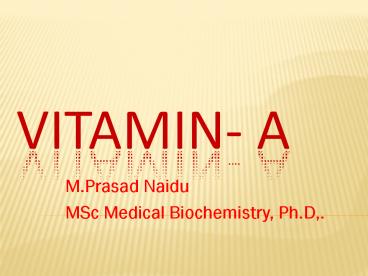vitamins - PowerPoint PPT Presentation
Title:
vitamins
Description:
BIOCHEMISTRY – PowerPoint PPT presentation
Number of Views:229
Title: vitamins
1
Vitamin- A
- M.Prasad Naidu
- MSc Medical Biochemistry, Ph.D,.
2
Vitamin- A
- Structure
- 6C beta-ionine ring with 11C polyprenoid side
chain with alternate double bonds. - Provitaminbeta carotene RetinalRetinal
- Active forms 1.Retinol
- 2.Retinal
- 3.Retinoic acid
3
Poly isoprenoid side chain
RDA 0.7 mg
4
(No Transcript)
5
Vitamin A
- Retinol Retinal retinoicacid
All-trans Retinal A1 common in circulation. - 11cis- Retinal form is present in rhodopsin.
- Active forms are heat stable and light sensitive.
6
Vitamin A
- Sources
- Animal marine fish liver oils
- Plant - mango\papaya\carrot
- RDA 1000 ug \ day
- 1 RE 1ug of retinol 0.6 ug of betacarotene
7
Vitamin A
8
.
- FUNTIONS
- Retinal and Retinol vision
- Retinoic acid
- cell differentiation
glycoprotein synthesis
reproduction. - 3.Beta-carotene- Anti-oxidant
9
Walds visual cycle
- The Cyclic events that occur in the process of
vision is visual cycle. . - Rhodopsin is a photoreceptor present in retinal
rod cells. - Rhodopsin is a conjugated protein with 11-cis
retinal and protein opsin.
10
FUNCTIONS OF VIT A
WALDS VISUAL CYCLE
11
(No Transcript)
12
Defeciency
- primary causes dietary
- secondarycausesmalabsorption
- Results in
- Night blindness
- Conjunctival xerosis
- Bitots spots
- Corneal xerosis
- keratomalasia
- Blindness
13
.
- Toxicity of vit-A is either due to
- 1. over-dosage of vit-A supplements
- 2. excess dietary intake
- As vitamin A is not excreted from the body it
isccumulated in liver producing toxic - effects
- Toxicity produces headache , nausea , vomitings
, liver damage alterations in the skin and mucous
membranes etc.
14
.
- Vit-A can be used to treat diseases where
epithelial surface is damaged. - Retinoic acid acts on cell differentiation and
growth therefore used as a drug. - It is used to treat diseases like Measles, Acne,
Psoriasis , Leukemia etc.
15
(No Transcript)
16
(No Transcript)
17
Visual cycle
- meta-rhodopsin
- Transducin Transducin A
- PDE
PDE A - CGMP
GMP
18
VISUAL CYCLE
- Decreased CGMP
- closes Na channels in rod cell membrane
- hyper polarization of rod cell membrane
- generation of nerve impulse to visual cortex
19
Vitamin D
- Structure
- plants - Ergosterol Ergocalciferol
D2 - Active form in animals is calcitriol
UV
20
(No Transcript)
21
Vitamin D
- Sources
- 1. sunlight
- 2. animal sources fish liver oils \ eggs
- 3. plant sources
- 4. food fortification milk\ butter
- RDA
- 200-400 IU \ day
22
Vitamin D
- Digestion \ absorption \ transport
- Digested and absorbed in small intestine
- using bile salts .
- Vit-D is transported from intestine to
circulation by chylomicrons and stored in the
liver.
23
Vitamin D
- Synthesis of vit-D
- Regulation of synthesis by Ca and PO4.
- Low calcium stimulates PTH secretion which
activates 1- hydroxylase
24
functions
- Vit-D plays a major role in regulation of
calcium and phosphate levels by mainly acting on
3 different organs. - Intestine increases absorption of Ca and PO4
- Bone increases deposition of CaPO4 thus
increasing mineralization of bones . - Kidneys reabsorbs Ca and decreases Ca
excretion.
25
(No Transcript)
26
Vitamin D
- Deficiency
- Children ---Rickets
- Adults ------ Osteomalacia
27
Vitamin D
- Toxicity
- hyper-vitaminosis D causes toxic effects
- like de-mineralization , hyper-calcemia ,
renal calculi etc.
28
(No Transcript)
29
(No Transcript)
30
(No Transcript)
31
(No Transcript)
32
(No Transcript)
33
(No Transcript)
34
(No Transcript)
35
Absorption and Transport
36
Iron deficiency anemia
- Laboratory findings
- Hypochromic microcytic anemia
- ? ferritin ( 30 to 300 Nanogm/ml)
- ? serum iron (50 to175 µgm/dl)
- ? TIBC (300 to 350 µgm/dl)
- ? transferrin (200 to 400 mg/dl)
Spoon-shaped nails (koilonychia)
37
Dental fluorosis
38
(No Transcript)
39
(No Transcript)
40
(No Transcript)
41
(No Transcript)
42
Thank q

